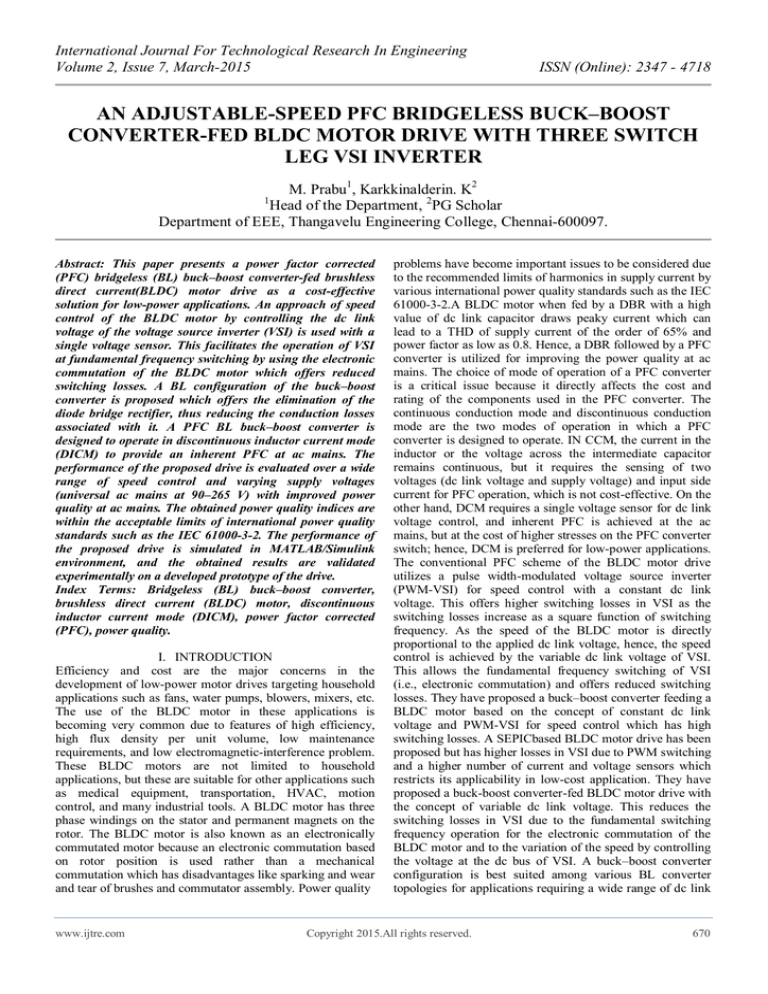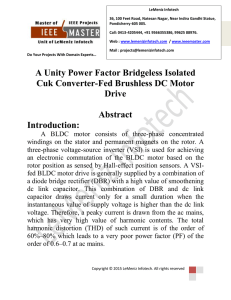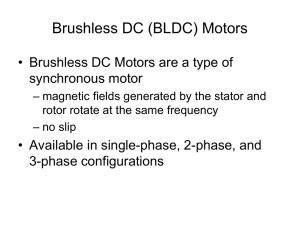
International Journal For Technological Research In Engineering
Volume 2, Issue 7, March-2015
ISSN (Online): 2347 - 4718
AN ADJUSTABLE-SPEED PFC BRIDGELESS BUCK–BOOST
CONVERTER-FED BLDC MOTOR DRIVE WITH THREE SWITCH
LEG VSI INVERTER
M. Prabu1, Karkkinalderin. K2
1
Head of the Department, 2PG Scholar
Department of EEE, Thangavelu Engineering College, Chennai-600097.
Abstract: This paper presents a power factor corrected
(PFC) bridgeless (BL) buck–boost converter-fed brushless
direct current(BLDC) motor drive as a cost-effective
solution for low-power applications. An approach of speed
control of the BLDC motor by controlling the dc link
voltage of the voltage source inverter (VSI) is used with a
single voltage sensor. This facilitates the operation of VSI
at fundamental frequency switching by using the electronic
commutation of the BLDC motor which offers reduced
switching losses. A BL configuration of the buck–boost
converter is proposed which offers the elimination of the
diode bridge rectifier, thus reducing the conduction losses
associated with it. A PFC BL buck–boost converter is
designed to operate in discontinuous inductor current mode
(DICM) to provide an inherent PFC at ac mains. The
performance of the proposed drive is evaluated over a wide
range of speed control and varying supply voltages
(universal ac mains at 90–265 V) with improved power
quality at ac mains. The obtained power quality indices are
within the acceptable limits of international power quality
standards such as the IEC 61000-3-2. The performance of
the proposed drive is simulated in MATLAB/Simulink
environment, and the obtained results are validated
experimentally on a developed prototype of the drive.
Index Terms: Bridgeless (BL) buck–boost converter,
brushless direct current (BLDC) motor, discontinuous
inductor current mode (DICM), power factor corrected
(PFC), power quality.
I. INTRODUCTION
Efficiency and cost are the major concerns in the
development of low-power motor drives targeting household
applications such as fans, water pumps, blowers, mixers, etc.
The use of the BLDC motor in these applications is
becoming very common due to features of high efficiency,
high flux density per unit volume, low maintenance
requirements, and low electromagnetic-interference problem.
These BLDC motors are not limited to household
applications, but these are suitable for other applications such
as medical equipment, transportation, HVAC, motion
control, and many industrial tools. A BLDC motor has three
phase windings on the stator and permanent magnets on the
rotor. The BLDC motor is also known as an electronically
commutated motor because an electronic commutation based
on rotor position is used rather than a mechanical
commutation which has disadvantages like sparking and wear
and tear of brushes and commutator assembly. Power quality
www.ijtre.com
problems have become important issues to be considered due
to the recommended limits of harmonics in supply current by
various international power quality standards such as the IEC
61000-3-2.A BLDC motor when fed by a DBR with a high
value of dc link capacitor draws peaky current which can
lead to a THD of supply current of the order of 65% and
power factor as low as 0.8. Hence, a DBR followed by a PFC
converter is utilized for improving the power quality at ac
mains. The choice of mode of operation of a PFC converter
is a critical issue because it directly affects the cost and
rating of the components used in the PFC converter. The
continuous conduction mode and discontinuous conduction
mode are the two modes of operation in which a PFC
converter is designed to operate. IN CCM, the current in the
inductor or the voltage across the intermediate capacitor
remains continuous, but it requires the sensing of two
voltages (dc link voltage and supply voltage) and input side
current for PFC operation, which is not cost-effective. On the
other hand, DCM requires a single voltage sensor for dc link
voltage control, and inherent PFC is achieved at the ac
mains, but at the cost of higher stresses on the PFC converter
switch; hence, DCM is preferred for low-power applications.
The conventional PFC scheme of the BLDC motor drive
utilizes a pulse width-modulated voltage source inverter
(PWM-VSI) for speed control with a constant dc link
voltage. This offers higher switching losses in VSI as the
switching losses increase as a square function of switching
frequency. As the speed of the BLDC motor is directly
proportional to the applied dc link voltage, hence, the speed
control is achieved by the variable dc link voltage of VSI.
This allows the fundamental frequency switching of VSI
(i.e., electronic commutation) and offers reduced switching
losses. They have proposed a buck–boost converter feeding a
BLDC motor based on the concept of constant dc link
voltage and PWM-VSI for speed control which has high
switching losses. A SEPICbased BLDC motor drive has been
proposed but has higher losses in VSI due to PWM switching
and a higher number of current and voltage sensors which
restricts its applicability in low-cost application. They have
proposed a buck-boost converter-fed BLDC motor drive with
the concept of variable dc link voltage. This reduces the
switching losses in VSI due to the fundamental switching
frequency operation for the electronic commutation of the
BLDC motor and to the variation of the speed by controlling
the voltage at the dc bus of VSI. A buck–boost converter
configuration is best suited among various BL converter
topologies for applications requiring a wide range of dc link
Copyright 2015.All rights reserved.
670
International Journal For Technological Research In Engineering
Volume 2, Issue 7, March-2015
voltage control (i.e., bucking and boosting mode) have
presented BL buck and boost converters, respectively. This
paper presents a BL buck–boost converter-fed BLDC motor
drive with variable dc link voltage of VSI for improved
power quality at ac mains with reduced components.
II. PROPOSED PFC BL BUCK–BOOST CONVERTERFEDBLDC MOTOR DRIVE
ISSN (Online): 2347 - 4718
A. Operation during Positive and Negative Half Cycles of
Supply Voltage
In the proposed scheme of the BL buck–boost converter,
switches Sw1 and Sw2 operate for the positive and negative
half cycles of the supply voltage, respectively. During the
positive half cycle of the supply voltage, switch Sw1,
inductor Li1,and diodes D1 and Dpare operated to transfer
energy to dclink capacitor Cd as shown in Fig. 2(a)–(c).
Similarly, for the negative half cycle of the supply voltage,
switch Sw2, inductorLi2, and diodes D2 and Dnconduct as
shown in Fig. 3(a)–(c).In the DICM operation of the BL
buck–boost converter, the current in inductor Li becomes
discontinuous for a certain duration in a switching period.
Fig. 2(d) shows the waveforms of different parameters
during the positive and negative half
cycles of supply voltage.
Fig. 1. Proposed BLDC motor drive with front end BL buck–
boost converter.
Fig. 1 shows the proposed BL buck–boost converter-based
VSI-fed BLDC motor drives. The parameters of the BLbuck–
boost converter are designed such that it operates in
discontinuous inductor current mode (DICM) to achieve an
inherent power factor correction at ac mains. The speed
control of BLDC motor is achieved by the dc link voltage
control of VSI using a BL buck–boost converter. This
reduces the switching losses in VSI due to the low frequency
operation. A hardware implementation of the proposed
BLDC motor drive is carried out to demonstrate the
feasibility of the proposed drive over a wide range of speed
control with improved power quality at ac mains. of VSI for
the electronic commutation of the BLDC motor. The
performance of the proposed drive is evaluated for a wide
range of speed control with improved power quality at ac
mains. The proposed configuration of the BL buck–boost
converter has the minimum number of components and least
number of conduction devices during each half cycle of
supply voltage which governs the choice of the BL buck–
boost converter for this application.
III. PRINCIPLES OF OPERATION
The operation of the PFC BL buck–boost converter is
classified into two parts which include the operation during
the positive and negative half cycles of supply voltage and
during the complete switching cycle.
www.ijtre.com
Fig. 2. Operation of the proposed converter in different
modes (a)–(c) fora positive half cycle of supply voltage and
(d) the associated waveforms.(a) Mode I. (b) Mode II. (c)
Mode III. (d)Waveforms for positive and negative half
cycles of supply voltage.
Copyright 2015.All rights reserved.
671
International Journal For Technological Research In Engineering
Volume 2, Issue 7, March-2015
B. Operation during Complete Switching Cycle
Three modes of operation during a complete switching
cycleare discussed for the positive half cycle of supply
voltage asshown hereinafter.
Mode I: In this mode, switch Sw1 conducts to charge
theinductor Li1; hence, an inductor current iLi1 increases in
thismode as shown in Fig. 2(a). Diode Dpcompletes the input
sidecircuitry, whereas the dc link capacitor Cd is discharged
by theVSI-fed BLDC motor as shown in Fig. 3(d).
Mode II: As shown in Fig. 2(b), in this mode of operation,
switch Sw1 is turned off, and the stored energy in
inductorLi1 is transferred to dc link capacitor Cd until the
inductor is completely discharged. The current in inductor
Li1 reduces and reaches zero as shown in Fig. 3(d). Mode III:
In this mode, inductor Li1 enters discontinuous conduction,
i.e., no energy is left in the inductor; hence, currentiLi1
becomes zero for the rest of the switching period. As shown
in Fig. 2(c), none of the switch or diode is conducting in this
mode, and dc link capacitor Cd supplies energy to the load;
hence, voltage Vdc across dc link capacitor Cd starts
decreasing. The operation is repeated when switch Sw1 is
turned on again after a complete switching cycle.
ISSN (Online): 2347 - 4718
Fig. 3. Operation of the proposed converter in different
modes (a)–(c) fora negative half cycle of supply voltage and
(d) the associate waveforms.(a)Mode I. (b)Mode II. (c)Mode
III. (d)Waveforms during complete switching cycle.
IV. CONTROL OF BLDC MOTOR: ELECTRONIC
COMMUTATION
An electronic commutation of the BLDC motor includes the
proper switching of VSI in such a way that a symmetrical
current is drawn from the dc link capacitor for 120◦ and
placed symmetrically at the center of each phase. A Halleffect position sensor is used to sense the rotor position on a
span of60◦, which is required for the electronic commutation
of the BLDC motor. The conduction states of two switches
(S1 andS4) are shown in Fig. 4. A line current iab is drawn
from thedc link capacitor whose magnitude depends on the
applied dclink voltage (Vdc), back electromotive forces
(EMFs) (ean andebn), resistances (Ra and Rb), and selfinductance and mutualinductance (La, Lb, and M) of the
stator windings. Table Ishows the different switching states
of the VSI feeding a BLDCmotor based on the Hall-effect
position signals (Ha − Hc).
Fig. 4. Operation of a VSI-fed BLDC motor when switches
S1 and S4 are conducting.
TABLE I
SWITCHING STATES FOR ACHIEVING ELECTRONIC
COMMUTATION OF BLDC MOTOR BASED ON HALLEFFECT POSITION SIGNALS
www.ijtre.com
Copyright 2015.All rights reserved.
672
International Journal For Technological Research In Engineering
Volume 2, Issue 7, March-2015
V. CONCLUSION
A PFC BL buck–boost converter-based VSI-fed BLDC
motor drive has been proposed targeting low-power
applications. A new method of speed control has been
utilized by controlling the voltage at dc bus and operating the
VSI at fundamental frequency for the electronic commutation
of the BLDC motor for reducing the switching losses in VSI.
The front-end BLbuck–boost converter has been operated in
DICM for achieving an inherent power factor correction at ac
mains. A satisfactory performance has been achieved for
speed control and supply voltage variation with power
quality indices within the acceptable limits of IEC 61000-3-2.
Moreover, voltage and current stresses on the PFC switch
have been evaluated for determining the practical application
of the proposed scheme. Finally, an experimental prototype
of the proposed drive has been developed to validate the
performance of the proposed BLDC motor drive under speed
control with improved power quality at ac mains. The
proposed scheme has shown satisfactory performance, andit
is a recommended solution applicable to low-power BLDC
motor drives.
ISSN (Online): 2347 - 4718
981, Oct. 2003.
[10] B. Singh, S. Singh, A. Chandra, and K. Al-Haddad,
“Comprehensivestudy of single-phase ac-dc power
factor corrected converters withhigh frequency
isolation,” IEEE Trans. Ind. Informat., vol. 7, no. 4,
pp. 540–556, Nov. 2011.
REFERENCES
[1] W. Wei, L. Hongpeng, J. Shigong, and X. Dianguo,
“A novel bridgelessbuck-boost PFC converter,” in
IEEE PESC/IEEE Power Electron. Spec.Conf., Jun.
15–19, 2008, pp. 1304–1308.
[2] J. Moreno, M. E. Ortuzar, and J. W. Dixon,
“Energy-management systemfor a hybrid electric
vehicle,
using ultracapacitors and neural
networks,”IEEE Trans. Ind. Electron., vol. 53, no. 2,
pp. 614–623, Apr. 2006.
[3] Y. Chen, C. Chiu, Y. Jhang, Z. Tang, and R. Liang,
“A driver for the singlephasebrushless dc fan motor
with hybrid winding structure,” IEEE Trans.Ind.
Electron., vol. 60, no. 10, pp. 4369–4375, Oct. 2013.
[4] X. Huang, A. Goodman, C. Gerada, Y. Fang, and Q.
Lu, “A single sidedmatrix converter drive for a
brushless dc motor in aerospace applications,”IEEE
Trans. Ind. Electron., vol. 59, no. 9, pp. 3542–3552,
Sep. 2012.
[5] H. A. Toliyat and S. Campbell, DSP-Based
Electromechanical MotionControl. Boca Raton, FL,
USA: CRC Press, 2004.
[6] P. Pillay and R. Krishnan, “Modeling of permanent
magnet motor drives,”IEEE Trans. Ind. Electron.,
vol. 35, no. 4, pp. 537–541, Nov. 1988.
[7] Limits for Harmonic Current Emissions (Equipment
Input Current ≤16 APer Phase), Int. Std. IEC 610003-2, 2000.
[8] S. Singh and B. Singh, “A voltage-controlled PFC
Cuk converter basedPMBLDCM drive for airconditioners,” IEEE Trans. Ind. Appl., vol. 48,no. 2,
pp. 832–838, Mar./Apr. 2012.
[9] B. Singh, B. N. Singh, A. Chandra, K. Al-Haddad,
A. Pandey, andD. P. Kothari, “A review of singlephase improved power quality acdcconverters,”
IEEE Trans. Ind. Electron., vol. 50, no. 5, pp. 962–
www.ijtre.com
Copyright 2015.All rights reserved.
673





